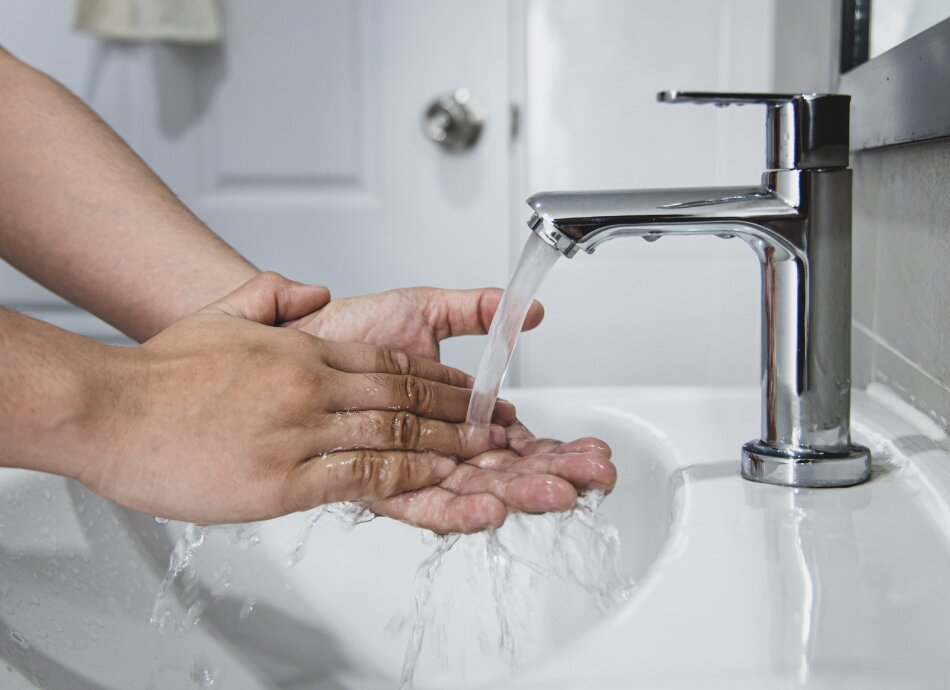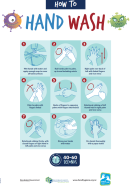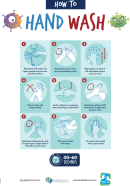Hand washing
Key points about hand hygiene
- Every day you come in contact with thousands of invisible germs. These can make you sick.
- Clean your hands regularly, even if they don’t look dirty.
- Wash your hands with soap and water, and dry them thoroughly.
- Use alcohol-based hand sanitiser if you don’t have immediate access to soap and water.

Video: Why does hand-washing work?
This video may take a few moments to load.
(American Heart Association, US, 2020)
When your hands look dirty, it's easy to tell that they need washing. But most of the time you won't see the germs that need to be cleaned off. That's why you should always wash and dry your hands at the following times:
| Before | After |
|
|
|
Tips:
|
|
- Wet your hands with clean, running water – use warm water if available. Turn off the tap and apply soap.
- Lather your hands by rubbing them together with soap – liquid is best. Rub hands together until the soap makes bubbles. Make sure to rub on both sides of both hands and in between your fingers and thumbs.
- Rub your hands for at least 20 seconds. Need a timer? Hum the Happy Birthday song from beginning to end twice.
- Rinse your hands well under clean, running water – use warm water if available.
- Dry your hands – using a paper towel is best or, if at home, a clean dry towel.
Note: Plain soap is as good as antiseptic soap
Antiseptics may be added to hand cleansers. However, plain soap has been shown to be just as effective as hand cleansers or soaps with added antiseptic agents.
Video: Golden Rules with Panatahi - Hand Hygiene
This video may take a few moments to load.
(Ministry of Health, NZ, 2020)
If soap and water are not available, an alcohol-based hand sanitiser that can be used without water is a good alternative. Look for one with 60–80% alcohol (ideally 75%).
- Apply one squirt of hand rub in a cupped hand.
- Rub hands palm to palm, up to and including your wrists.
- Rub your right palm over the back of your left hand with linked fingers and vice versa.
- Rub palm to palm with fingers linked.
- Rub the backs of your fingers to opposing palms with fingers interlocked.
- Rub around your left thumb held in your right palm and vice versa.
- Rub around firmly the closed fingers of your right hand in your left palm and vice versa.
- Once dry, your hands are safe.
|
Hand sanitiser doesn't kill as many germs as soap does |
|
Hand sanitiser doesn't kill some of the germs that cause diarrhoea (runny poos) and vomiting (being sick), so you should wash your hands with soap and water after contact with someone with these symptoms, even if you used gloves. Washing your hands with soap is also more effective than hand sanitiser against other viruses such as COVID-19. |
Hygiene and hand washing(external link) KidsHealth, NZ
Hand hygiene(external link) Hand Hygiene, NZ
Hand washing – clean hands save lives(external link) Centre for Disease Control & Prevention, US
Why? Show me the science – data behind why & how to wash hands(external link) Centre for Disease Control & Prevention, US
Resources
How to hand wash(external link) HQSC, Ministry of Health, NZ and Hand Hygiene NZ English(external link), te reo Māori(external link), Samoan(external link), Tongan(external link), Arabic(external link), Hindi(external link), Chinese (simplified)(external link)
How to hand rub(external link) HQSC, Ministry of Health, NZ and Hand Hygiene NZ English(external link), Hindi(external link), te reo Māori(external link), Samoan(external link), Tongan(external link), Arabic(external link), Chinese (Simplified)(external link), Chinese (traditional)(external link)
Are you giving germs a hand?(external link) HQSC NZ, Ministry of Health NZ & ACC NZ English(external link), te reo Māori(external link), Samoan(external link), Tongan(external link), Chinese (simplified)(external link), Hindi(external link)
References
- Antibacterial soap no more effective than plain soap at reducing bacterial contamination(external link) Oxford University Press via ScienceDaily, 16 September 2015
Five moments for hand hygiene(external link) Hand Hygiene NZ
Hand hygiene NZ guidelines(external link) Hand Hygiene NZ
Hand hygiene(external link) Health Quality & Safety Commission NZ
Hand hygiene resource kit for health professionals(external link) Health Quality & Safety Commission NZ
Show me the science – data behind why and how to wash hands(external link) Centre for Disease Control & Prevention
Celebrating New Zealand's hand hygiene improvement journey: 2008–2015(external link) Health Quality & Safety Commission NZ
Videos about hand hygiene
Clinicians talk about the importance of hand hygiene(external link) Health Quality & Safety Commission NZ, 2012
5 moments for hand hygiene(external link) Hand Hygiene, AU, 2015
Resources
How to hand wash(external link) Auckland District Health Board and Hand Hygiene NZ
- Wash hands when they're visibly soiled.
- Wash hands after contact with patients who have diarrhoea or vomiting (or when advised to do so).
- Alcohol based hand rub can be used at all other times.
How to hand rub(external link) Auckland District Health Board and Hand Hygiene NZ
- Wash hands when they're visibly soiled.
- Use hand rub to clean hands.
Clean hands(external link) Auckland District Health Board and Hand Hygiene NZ
For safe hands, clean at these times(external link) Auckland District Health Board and Hand Hygiene NZ
Gloves are not a substitute for hand hygiene(external link) Auckland District Health Board and Hand Hygiene NZ
Hand hygiene protects patients – a guide for healthcare staff(external link) Auckland District Health Board and Hand Hygiene NZ
Brochures

How to hand wash
HQSC, Ministry of Health, NZ and Hand Hygiene NZ
English, te reo Māori, Samoan, Tongan, Arabic, Hindi, Chinese (simplified)

How to hand rub
HQSC, Ministry of Health, NZ and Hand Hygiene NZ
English, Hindi, te reo Māori, Samoan, Tongan, Arabic, Chinese (simplified), Chinese (traditional)
Credits: Healthify Editorial Team. Healthify is brought to you by Health Navigator Charitable Trust.
Reviewed by: Dr Alice Miller, FRNZCGP, Wellington
Last reviewed:
Page last updated:





